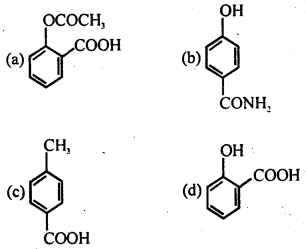CBSE Class 12 Biology – MCQ and Online Tests – Unit 12 – Biotechnology and its Applications
Every year CBSE conducts board exams for 12th standard. These exams are very competitive to all the students. So our website provides online tests for all the 12th subjects. These tests are also very effective and useful for those who preparing for competitive exams like NEET, JEE, CA etc. It can boost their preparation level and confidence level by attempting these chapter wise online tests.
These online tests are based on latest CBSE Class 12 syllabus. While attempting these our students can identify the weak lessons and continuously practice those lessons for attaining high marks. It also helps to revise the NCERT textbooks thoroughly.
CBSE Class 12 Biology – MCQ and Online Tests – Unit 12 – Biotechnology and its Applications
Question 1.
By means of following Trans gene expression obtained:
(a) Inhibition of a Innate gene
(b) An occured Biosynthetic passway develop
(c) A protein occured with genotype expressed his desired
(d) None of the above
Answer
Answer: (d) None of the above
Question 2.
Adjoining of exotic gene is crop is called :
(a) Genetic Engineering
(b) Bio architecture
(c) Tissue culture
(d) Immunisation
Answer
Answer: (a) Genetic Engineering
Question 3.
Transgenic Golden Rice Highly Nutrient value for:
(a) Lysine
(b) Methionine
(c) Glutanin
(d) Vitamin-A
Answer
Answer: (d) Vitamin-A
Question 4.
In a Transgenic crop gene for following:
(a) New protein synthesis
(b) Resistance from Antibiotics
(c) In the formation enzyme for Antibiotics
(d) All of these
Answer
Answer: (d) All of these
Question 5.
Transgenic Bacteria and m the making of following :
(a) Epinephrin
(b) Human Insullin
(c) Glutanin
(d) Thyroxin
Answer
Answer: (b) Human Insullin
Question 6.
Monoclonal antibodies are obtained from:
(a) One parent for one antigen
(b) Different parents for one antigen
(c) One parent for many antigens
(d) Many parents for many antigens
Answer
Answer: (b) Different parents for one antigen
Question 7.
B7 Toxsin is :
(a) Intracellular lipid
(b) Intracellular crystal protein
(c) Extracellular Crystal protein
(d) Lipid
Answer
Answer: (b) Intracellular crystal protein
Question 8.
Somatic hybridization can be done by:
(a) By Protoplast fusion
(b) By Haploid anther
(c) By cell culture
(d) ByPollen culture
Answer
Answer: (a) By Protoplast fusion
Question 9.
Which one of the following is a step of PCR?
(a) Denaturation
(b) Annealing
(c) Extension
(d) All of these
Answer
Answer: (a) Denaturation
Question 10.
Restriction Endonuclease used in RDT obtained from:
(a) Plasmid
(b) Bacterial ceils
(c) Bacterophages
(d) All Prokaryotic cells
Answer
Answer: (b) Bacterial ceils
Question 11.
The Ti plasmid used in genetic engineering is obtained from:
(a) Bacillus thruingiensis
(b) E. Coii
(c) Agrobacterium hizogenes
(d) Agrobacterium tumefaciens
Answer
Answer: (d) Agrobacterium tumefaciens
Question 12.
Which Vitamin has been transferred to golden rice?
(a) Vit-B12
(b) Vit-A
(c) Vit-D
(d) Vit-C
Answer
Answer: (b) Vit-A
Question 13.
From which one of the following plants, the insecticide pyrethrum is prepared.
(a) Cymohopogen
(b) Tephrosia
(c) Crysanthemum
(d) Vitivera
Answer
Answer: (c) Crysanthemum
Question 14.
Biopiracy is related to the following:
(a) Traditional knowledge
(b) Biomolecules and Bioresources, Isolation of gene from Bioresources
(c) Bioresources
(d) All of the above
Answer
Answer: (d) All of the above
Question 15.
The sheep ‘Dolly’ was cloned by using somatic cells from donor’s:
(a) Udder
(b) Skin
(c) Tongue
(d) Earlobe
Answer
Answer: (c) Tongue
Question 16.
Recombinant DNA technology discovered by:
(a) Hargobind Khoorana
(b) James D. Watsan
(c) S. Kohen and H. Boer
(d) Sulton and Boveri
Answer
Answer: (c) S. Kohen and H. Boer
Question 17.
Golden rice is a transgenic crop of the future with the following improved trail:
(a) Insec resistance
(b) Hight lysine (essential amino acid) content
(c) High protein content
(d) High vitamin A content
Answer
Answer: (c) High protein content
Question 18.
The confirmatory test used to diagnose AIDA is:
(a) ELISA
(b) Western Plot
(c) ESR
(d) PCR
Answer
Answer: (a) ELISA
Question 19.
Some bacterial occured B-7 Toxin’s crystal not kill the Bacteria because of:
(a) Bacteria is Antoxin
(b) Toxin is unripened
(c) Toxin is inactive
(d) Bacteria enclosed toxin a special sell
Answer
Answer: (c) Toxin is inactive
Question 20.
Natural genetic engineer is :
(a) Bacillus subtilis
(b) Pseudomonas sp.
(c) Escherichia coli
(d) Agrobacterium tumefaciens
Answer
Answer: (a) Bacillus subtilis
Question 21.
First Transjenic crop was :
(a) Cotton
(b) Alsi
(c) Pea
(d) Tobacco
Answer
Answer: (d) Tobacco
Question 22.
Bt toxin is :
(a) Intracellular lipid
(b) Intracellular crystalline protein
(c) Extracellular crystalline protein
(d) Lipid
Answer
Answer: (a) Intracellular lipid
Question 23.
Desired properties plants and Animals are possible by Which reproduction.
(a) Genetic Engineering
(b) Chromosomal Engineering
(c) Ekabana technology
(d) Bonsai technology
Answer
Answer: (a) Genetic Engineering
Question 24.
First biochemical to be produced commercially by microbial cloning and genetic engineering:
(a) Human insulin
(b) Penicillin
(c) Interferons
(d) Fertility factor
Answer
Answer: (b) Penicillin
Question 25.
Anticoagulant hirudin is found in:
(a) In Snake
(b) In Lizard
(c) In Leech
(d) In Scorpion
Answer
Answer: (c) In Leech
Question 26.
The species used as natural genetic engineer is :
(a) Agrobacterim tumefaciens
(b) Bacillus thruingiensis
(c) Aspergillus
(d) Drosophila
Answer
Answer: (d) Drosophila
Question 27.
Bacillus thruingiensis (Bt) strains have been used for designing nobel:
(a) Biofertilizers
(b) Biometallurgical techniques
(c) Biomineralization processes
(d) Bioinsecticidal plants
Answer
Answer: (a) Biofertilizers
Question 28.
Most widely used Bioweapon is:
(a) Bacillus subtilis
(b) Biometallurgial techniques
(c) Bacillus anthracis
(d) Bioinsecticidal plant
Answer
Answer: (d) Bioinsecticidal plant
Question 29.
A technology which has found immense use in solving cases of disputed percentage is:
(a) Polymerase chain reaction
(b) DNA finger printing
(c) None of these
(d) Both (a) and (b)
Answer
Answer: (b) DNA finger printing
Question 30.
Herbicide resistant gene in plants is:
(a) Ct
(b) Mt
(c) Bt
(d) Gst
Answer
Answer: (d) Gst















